If Albert Einstein had never been born, would it have changed when nuclear weapons were first produced? For whatever reason, I’ve seen this question being asked repeatedly on Internet forums, as odd as it is. It’s kind of a silly question. You can’t go in and tweak one variable in the past and then think you could know what the outcome would be. History is a chaotic system; start removing variables, who knows what would happen. Much less a variable named Albert Einstein, one of the most influential physicists of the 20th century, and whose importance extended well past the equations he wrote… and those were pretty important equations, at that!

Einstein’s 1946 cover of Time magazine. The mushroom cloud is a beautifully executed combination of the Trinity and Nagasaki mushroom clouds.
On the other hand, this kind of science-fiction counterfactual can have its usefulness as a thought experiment. It isn’t history, but it can be used to illustrate some important aspects about the early history of the atomic bomb that a lot of people don’t know, and to undo a little bit of the “great man” obsession with bomb history. Albert Einstein has been associated with the bomb both through his famous mass-energy equivalence calculation (E=mc²) and because of the famous Einstein-Szilard letter to Roosevelt in 1939. On the face of it, this gives him quite a primary role, and indeed, he usually shows up pretty quickly at the beginning of most histories of the Manhattan Project. But neither E=mc² nor the Einstein-Szilard letter were as central to the Manhattan Project’s success as people realize — either scientifically or historically.
In terms of the science, E=mc² gets a lion’s share of attention, most perfectly expressed by Einstein’s portrait on the cover of Time magazine in 1946 (above) with his equation emblazoned on a mushroom cloud. A lot of people seem to think that E=mc² played a key role in the development of the bomb, that the weapon just falls out of the physics. This is wrong. The equation can help one understand why atomic bombs work, but it doesn’t really tell you how they work, or whether you would expect them to even be possible.
The way I like to put it is this: E=mc² tells you about as much about an atomic bomb as Newton’s laws do about ballistic missiles. At some very “low level” the physics is crucial to making sense of the technology, but the technology does not just “fall out” of the physics in any straightforward way, and neither of those equations tell you whether the technology is possible. E=mc² tells you that on some very deep level, energy and mass are equivalent, and the amount of energy that mass is equivalent is gigantic. But it says nothing about the mechanism of converting mass into energy, either whether one exists in the first place, or whether it can be scaled up to industrial or military scales. It gives no hints as to even where to look for such energy releases. After the fact, once you know about nuclear fission and can measure mass defects and things like that, it helps you explain very concisely where the tremendous amounts of energy come from, but it gives you no starting indications.
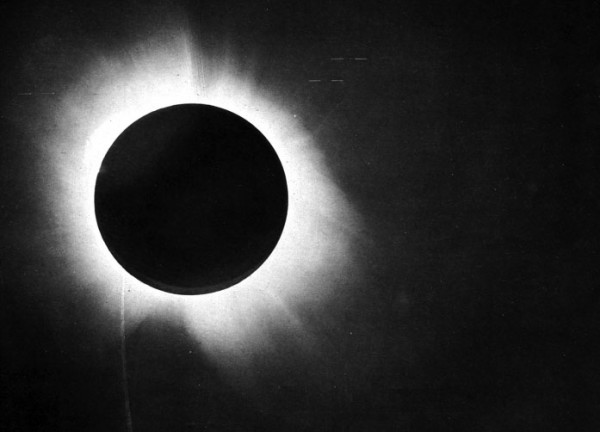
Eddington’s famous plate of the 1919 solar eclipse, which helped confirm Einstein’s theory of General Relativity. Very cool looking, and interesting science. But not relevant to atomic bombs. Source.
What about the rest of Einstein’s main theoretical work, both Special and General Relativity Theory? They are pretty irrelevant to bomb-making. The physical processes that take place inside atomic bombs are what physicists call “non-relativistic.” Relativity theory generally only shows its hand when you are talking about great speeds (e.g. large fractions of the speed of light) or great masses (e.g. gravitational fields), and neither of those come into play with fission bombs. You can neglect relativity when doing the math to make a bomb. 1
An intelligent follow-up question might be: “well, just because relativity theory didn’t play a role in the bomb process itself doesn’t answer the question of whether it started physics on a path that led to the bomb, does it?” Without getting into a long timeline of the “science that led to the bomb,” here, I think we could reasonably summarize the situation like this: Einstein’s 1905 papers (of which E=mc² was one) did indeed play a role in the subsequent developments that followed, but perhaps not as direct a one as people think. E=mc² didn’t inspire physicists to start looking into processes that converted mass to energy — they were already looking into those through an entirely separate (and earlier) line of development, namely the science of radioactivity and particle physics. The fact that huge amounts of energy were released through nuclear reactions, for example, had already been studied closely by the Curies, by Ernest Rutherford, and by Frederick Soddy prior (but only just) to 1905.
Arguably, the most important work Einstein did in this respect was his work on the photoelectric effect (for which he was awarded the Nobel Prize in Physics for 1921), which helped establish the physical reality of Max Planck’s idea of a quantum of energy, which helped kick off investigations into quantum theory in earnest. This had a big influence on the later direction of physics, even if Einstein himself was never quite comfortable with the quantum mechanics that developed in subsequent decades.
Did any of the relativity work lead, though, down the path that eventually arrived at the discovery of fission in 1939? I don’t think so. The experiments that Hahn, Meitner, and Strassman were doing in Berlin that lead to the discovery of fission in uranium were themselves careful replications of work that Fermi had done around 1934. Fermi’s work came directly out of an experimentalist, nuclear physics context where physicists were bombarding substances with all manner of subatomic particles to see what happened. It was most directly influenced by the discovery of the neutron as a new sub-atomic particle by Chadwick in 1932. This came out of work on atomic theory and atomic modeling that was being done by Rutherford and his students from the early 1910s-1920s. And this early nuclear physics came, most directly, out of the aforementioned context of radioactivity and experimental physics of the late 19th century.
None of which has a strong, direct connection to or from Einstein’s work in my mind. They have some overlaps of interest (e.g. Bohr was a student of Rutherford’s), but the communities working on these sorts of experimental problems are not quite the same as the more theoretical circle that Einstein himself worked in. 2 If we somehow, magically, removed Einstein’s early work from the equation here, does the output change much? There would be some reshuffling, probably, but I sort of think that Rutherford would still be doing his thing anyway, and from that much of the other work that led to the bomb would eventually come out, even if it had a somewhat different flavor or slightly different timeline.
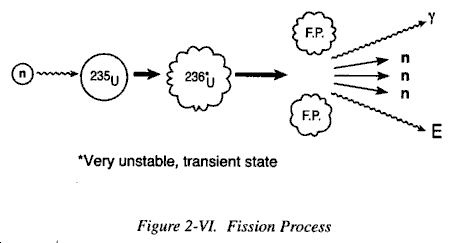
This is my least-favorite way of depicting the fission process, where energy (E) is a magic lightning bolt coming out of the splitting atom. In reality, most of the energy comes in the form of the two fission products (F.P. here) repelling from each other with great violence. Source.
Do you even need to know that E=mc² to make an atomic bomb? Perhaps surprisingly, you don’t! There are other, more physically intuitive ways to calculate (or measure) the energy release from a fission reaction. If you treat the fission process as being simply based on the electrostatic repulsion of two fission products, you get essentially the same energy output in the form of kinetic energy. This is how the physics of fission is often taught in actual physics classes, because it gives you a more concrete indication of how that energy is getting released (whereas E=mc² with the mass-defect makes it seem like a magical lightning bolt carries it away). There are other more subtle physical questions involved in making a bomb, some of which have Einstein’s influence on them in one way or another (e.g. Bose–Einstein statistics). But I think it is not totally crazy to say that even if you somehow imagine a world in which Einstein had never existed, that the physics of an atomic bomb would still work out fine — Einstein’s specific technical work wasn’t central to the problem at all. We also have not brought up the question of whether without Einstein, relativity in some form would have been discovered anyway. The answer is probably “yes,” as there were people working on similar problems in the same areas of physics, and once people started paying a close attention to the physics of radioactivity they were bound to stumble upon the mass-energy relationship anyway. This isn’t to denigrate or underestimate Einstein’s influence on physics, of course. What makes Einstein “Einstein” is that he, a single person, pulled off a great number of theoretical coups all at once. But if he hadn’t done that, there’s no reason to think that other people wouldn’t have come up with his theoretical insights individually, if slightly later.
What about Einstein’s most direct role, the famous Einstein-Szilard letter of 1939 that influenced President Roosevelt to set up the first Uranium Committee? This is a tricky historical question that could have (and may at some point) an entirely separate blog post relating to it. Its writing, contents, and influence are more complex than the standard “he wrote a letter, FDR created the Manhattan Project” understanding of it that gets boiled down in some popular accounts. My feeling about it, ultimately, is this: if the Einstein-Szilard letter hadn’t been written, it isn’t clear that anything would be terribly different in the outcome in terms of making the bomb. Something like the Uranium Committee might have been started up anyway (contrary to popular understanding, the letter was not the first time Roosevelt had been told about the possibility of nuclear fission), and even if it hadn’t, it isn’t clear that the Uranium Committee was necessary to end up with a Manhattan Project. The road from a fission program whose primary output was reports and a fission program whose primary output was atomic bombs was not a direct one. By early 1941, the Uranium Committee had failed to convince scientist-administrators that atomic bombs were worth trying to build. They had concluded that while atomic bombs were theoretically feasible, they were not likely to be built anytime soon. Had things stayed there, it seems unlikely the United States would have built a bomb ready to use by July/August 1945.
The “push” came from an external source: the British program. Their MAUD Committee (an equivalent of the Uranium Committee) had concluded that a nuclear weapon would be much easier to build than the United States had concluded, and sent an emissary (Mark Oliphant) to the United States to make sure this conclusion was understood. They caught Vannevar Bush’s ear in late 1941, and he (along with Ernest Lawrence, Arthur Compton, and others) wrested control of the uranium work out of the hands of the Uranium Committee, accelerated the work, and morphed it into the S-1 Committee. The name change is significant — it is one of the more vivid demonstrations of the increased degree of seriousness with which the work was taken, and the secrecy that came with it. By late 1942, the wheels for the full Manhattan Project were set into motion, and the work had become a real bomb-making program.
Einstein wasn’t involved with any of the later work that actually led to the bomb. He almost was, though: in late 1941, Bush considered consulting Einstein for help on the diffusion problem, but opted not to push for it — both because Einstein wasn’t regarded as politically reliable (he had a fat FBI file), and his approach to physics just wasn’t very right for practical problems. 3 Bush decided that Einstein would stay out of the loop.
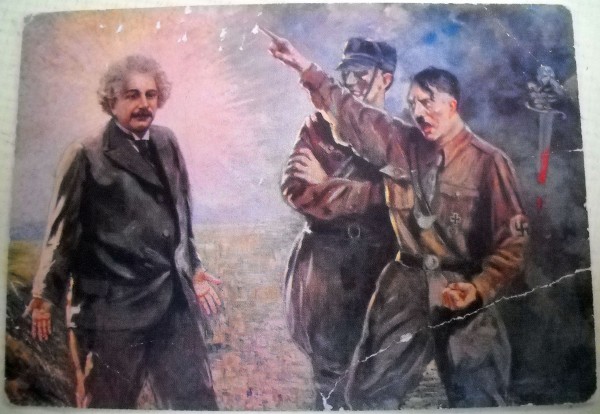
Unusual, rare anti-Nazi propaganda postcard from 1934, showing Hitler expelling Einstein from Germany, titled “The Ignominy of the 20th Century.” It is one of the most blatant visual renderings of Einstein as a “scientific saint.” Source.
Let’s sum it up. Did Einstein play a role in the creation of the atomic bomb? Of course — his physics isn’t irrelevant, and his letter to Roosevelt did start one phase of the work. But both of these things are less prominent than the Time-magazine-cover-understanding makes them out to be. They weren’t central to what became the Manhattan Project, and if you could somehow, magically, remove Einstein from the equation, it isn’t at all clear that the atomic bomb wouldn’t have been built around the time it actually was built. I don’t think you can really credit, or blame, Einstein for the atomic bomb, in any direct fashion. Einstein did play a role in things, but that role wasn’t as crucial, central, or direct as a lot of people imagine. If you could magically drop him out of history, I think very little in terms of atomic bombs would have been affected.
So why does the Einstein and the bomb myth persist? Why does everybody learn about the Einstein letter, if it wasn’t really was sparked the Manhattan Project? There are two answers here, I think. One is that Einstein was, even before the war, one of the best-known, best-recognized physicists of the 20th century, and was synonymous with revolutionary science and genius. Having him “predict” the atomic bomb with equations in 1905 — 40 years before one was set off — is the kind of “genius-story” that people love, even if it obscures more than it enlightens. It also has a high irony quotient, since Einstein was forced to flee from Germany when the Nazis took power.
But there’s another, perhaps more problematic aspect. In many early copies of the Smyth Report that were distributed by the government, copies of the Einstein letter were mimeographed and loosely inserted. The magnification of Einstein’s role was purposefully encouraged by the government in the immediate period after using the weapon. (And it was even a convenient myth for Einstein, as it magnified his own importance and thus potential influence.) Hanging the atomic bomb on Einstein’s head was an act of self-justification, of sorts. Einstein was the world’s greatest genius in the eyes of the public, and he was a well-known pacifist, practically a scientific saint. After all, if Einstein thought building a bomb was necessary, who could argue with him?
- As Robert Serber puts it: “Somehow the popular notion took hold long ago that Einstein’s theory of relativity, in particular his famous equation E = mc², plays some essential role in the theory of fission. Albert Einstein had a part in alerting the United States government to the possibility of building an atomic bomb, but his theory of relativity is not required in discussing fission. The theory of fission is what physicists call a non-relativistic theory, meaning that relativistic effects are too small to affect the dynamics of the fission process significantly.” Robert Serber, The Los Alamos Primer: The First Lectures on How to Build an Atomic Bomb (University of California Press, 1992), 7.[↩]
- For a good, non-teleological, non-bomb-centric approach to the context of 19th- and 20th-century physics, Helge Kragh’s Quantum Generations: A History of Physics in the Twentieth Century (Princeton University Press, 2002), is excellent.[↩]
- Einstein wasn’t entirely a head-in-the-clouds physicist, of course. He worked at the patent office, and as Peter Galison has written about, even his famous thought experiments were often motivated by experience with practical problems of time synchronization. And he did help invent a refrigerator with Leo Szilard. But his work on diffusion physics was too abstract, too focused on first-principle analysis, for use in producing a practical outcome.[↩]
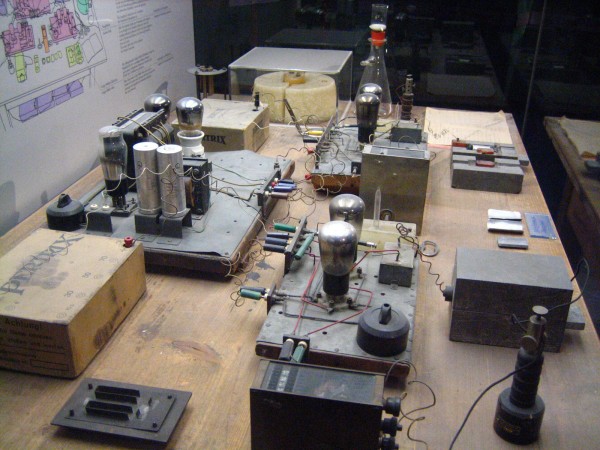
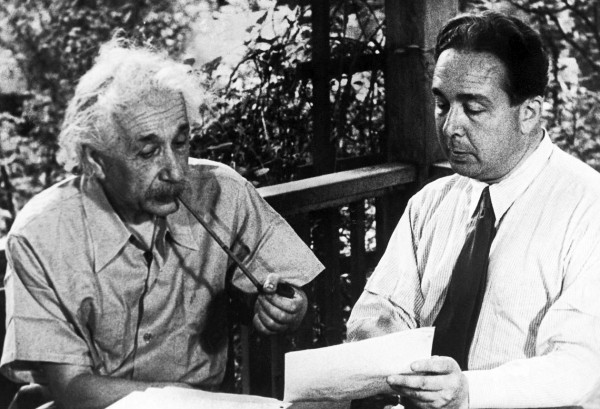


I may be one of those who asked the question, and no, I don’t think it’s a silly question. Here’s my thinking:
E=mc^2 is not an invention, it’s a discovery. Take the automobile, for example. If Henry Ford hadn’t come up with mass-production, would we have cars today? THAT would be a silly question, because the creation of the car was a gradual process, involving many innovations, one of them being the mass-production process.
In the case of Einstein’s E=mc^2, it only took accomplishing fission in Germany (and Einstein’s theory) to realize it might make a very powerful weapon. But Germany was not the only one to realize that. The U.S., of course, did. And so did the Japanese. Other countries, as well, might have considered it also, but they quickly abandoned their work or combined it with that of the U.S., Germany or Japan.
Getting back to Einstein. If the Germans hadn’t accomplished fission, and others hadn’t learned that thermal neutrons work better than fast neutrons, and that each fission results in 2+ neutrons being released, and that heavy water, graphite, paraffin, etc. slows down neutrons, and Einstein’s revelation that a small mass of uranium would release an enormous amount of energy, through fission, the atomic bomb would never have happened… or it would have first happened after WWII had ended.
Hi Bill —
If Hahn/Meitner/Strassmann hadn’t discovered fission when they did, it seems pretty probable that someone else would have soon. There were a lot of people doing experiments along these lines at that point, including the Joliot-Curies in France and people working at the Radiation Laboratory in Berkeley. So technically I wouldn’t put too much emphasis on the German discovery either as being anomalous.
In the immediate postwar, Ernest Lawrence wrote the following about this question:
Separately, I think in many cases most historians of science would say that the distinction you make between “invention” and “discovery” is a slippery one. You agree that the invention of automobiles “was a gradual process, involving many innovations,” but I think the same thing can be said of most scientific discoveries as well. We tend, in retrospect, to tell their narratives through a lens of individual genius, but just as in the case of the Edisons and Fords of the world, this is more of a narrative preference than it is a reflection of the historical state of things.
Hi Alex,
I was going to make two more points, but you beat me to it:
1. Einstein didn’t inform the Americans that E=mc^2. All physicists knew that since he came up with it in 1905. As you know, he informed the Americans that German intended to make a nuclear weapon, and that perhaps the Americans should consider it also.
2. Einstein wasn’t the first to realize that the fission of the uranium atom would result in a great deal of energy. (I don’t think Heisenberg ever called Einstein on the telephone, but he might have) But Einstein may have assumed that fission could be used in a weapon after someone (who?) discovered the “strong force,” the force that keeps neutrons and protons packed together in the nucleus of the atom.
What Einstein did, in fact, was come up with a simple formula to show that mass and energy are actually two sides of the same coin. You don’t need E=mc^2 to realize that fission can be used to make a weapon; you only need it to accurately predict how powerful that weapon would be.
For example (and this is a revelation, so keep it under your hat), a Japanese scientist who was interviewed by an American intelligence officer in 1945 (before the end of WWII) informed him that Dr. Yoshio Nishina was working on a tiny weapon capable of destroying a city. NO ONE believed him, but Einstein would have!
On point #2, Einstein really had nothing to do with fission and energy release. The fact that fission would release a lot of energy was immediately realized by Lise Meitner after she figured out more or less how it worked.
But something more to the point: You don’t need E=mc^2 to figure out how large a fission weapon would be. You can calculate the entire energy release (and physics students routinely do) without E=mc^2, or any kind of relativistic physics — if you calculate it instead as the kinetic energy of the two fission products being electrostatically repelled you get essentially the same value for average energy release. (There is a little more energy in the kinetic energy of the neutrons and other various radiations coming out of the process, but 80% of the energy release is from the kinetic energy of the fission products.)
Even though you can estimate the energy release using the coulomb potential, it seems careless to say that you can ignore the binding energy and the strong nuclear force. Certainly Meitner deserves more credit for the discover of nuclear fission, but to discount that E=mc^2 had nothing to with it discards the entire idea that physics, and science in general, builds directly on what came before it.
I think there are two things that need to be clarified.
1) Nuclear calculations are very difficult. Though you can calculate the energetics from the coulomb repulsion, they’re estimates, not an accurate theory. In order to properly determine nuclear reaction rates, you need to have a proper nuclear theory that includes binding energy, and thus Einstein’s mass-energy relationship. What’s a good exercise for first year students, isn’t good for when you’re building a bomb.
2) There seems to be a misunderstanding that E=mc^2 only applies in relativistic situations. Relativity applies to everything, it’s just that it’s effects are most apparent at speeds near the speed of light. The shocking thing about E=mc^2 is that it’s a result that is apparent at low speeds! It was derived using special relativity, but it’s actually a low energy (non-relativistic) equation. In fact, it’s so energy that the m in E=mc^2 is called the rest mass.
Hi James,
On your points:
1) I think you are actually overestimating their knowledge in the 1940s. They knew very little about the strong force (that knowledge came later in the 1950s). They did speak of binding energy, of course, but the numbers they were using for energy release were quite unrefined by modern standards (Bohr and Wheeler estimated a round 200 MeV in 1939; Serber uses 170 MeV in the Los Alamos Primer). This is well within the range received from the Coulomb repulsion calculation. I think it is worth pointing out that the hard nuclear physics of the Manhattan Project wasn’t in calculating energy release per fission — it was in the determination of cross sections, which was done largely empirically.
I’m not trying to argue, again, that they didn’t use the energy-mass equivalence equation at the time. I’m just pointing out that it is less central than people realize. The physics of the nucleus encompasses much more than that.
2) What I (and Serber) mean by the equations being non-relativistic is that the “wrongness” introduced by not taking relativity into effect doesn’t affect the outcome of the equation in such situations, of course. Reading The Los Alamos Primer, I think, makes it clear that E=mc^2 played little role in estimating reaction rates. The one place it is useful — knowing the energy output per fission — is dispensed with at the beginning by just stating the value. The result of the work concerns the work of estimating reaction rates, cross sections, critical masses, and whatnot, all of which don’t require anything remotely relativistic once you take for granted that around 200 MeV energy is being released in each fission reaction.
I agree.
In Robert Serber’s 1992 annotation to the second statement of his 1943 Los Alamos Primer, he explains “the direct energy release in the fission process,” in terms of “the electrostatic energy between two similarly charged particles,” namely the positively-charged nuclei of fission fragments. He calculates the force with which they repel each other and comes up with the power of the bomb.
I assume that this note, added five decades after his lectures that formed the Primer, shows what they were thinking at the time. True, there was matter lost (converted into energy) in jumping to the center of the Periodic Table, but he seems not to have used that fact in his calculations.
Yes, e= mc^2 is as relevant to a campfire as it is to a fission bomb — at a high level of abstraction, it provides some interesting insights and even provides a (very high) upper limit to how much energy could be extracted from a stick of firewood or a stick of uranium. But in terms of the practical measures needed to build a campfire or bomb, not so much.
If you expand the question to include, what did Einstein dicuss about atomic energy and the bomb, you’ll have a much broader answer. He was involved in some of the discussions in highlighting the dangers of atomic weapons, and his last signed act was the signing of the Russell-Einstein Manifesto, which led to Pugwash Conferences on Science & World Affairs.
Definitely! He leveraged his influence in the postwar quite well, to quite anti-nuclear ends. In that sense, it was advantageous to be so closely associated with the atomic bomb — it gave him a scientific authority on par with someone like Oppenheimer, combined with the moral authority of being the “scientific saint.”
Nice post Alex…I’ll bet this touched some nerve endings. Einstein *and* the Bomb = lots of ears perking up.
One might ask the more general question: Is there any scientific discovery “A” by discoverer “B” without who we’d never have “C”? The answer might be “no.”
Given enough time, then I’m sure the answer is “no”.
However, without Tycho Brahe’s observations Kepler would not have been able to show that planets orbit the sun in eclipses. I’m not aware of anyone else who was working in that direction.
In terms of a single theoretical contribution that was essential to developing nuclear weapons, I would propose the Bohr atom. It likely contributed to the understanding of the laboratory experiments in the late 1930s that eventually were interpreted as nuclear fission. It later was used as a basis for models of the nucleus that made sense of fission. Just a quick thought.
But I agree with Alex: there were many paths to fission and a bomb, and the one followed was heavily empirical.
Bill Streifer referred to Henry Ford “coming up with mass production”. He didn’t.
Adam’s Smith’s “The Wealth of Nations” (published in 1776) described an assembly
line for making pins. Mass production with interchangable parts was in use in France
in the 1780s (while US Ambassador to France, Thomas Jefferson wrote about seeing
this when visiting a French munitions factory).
What Ford *did* pioneer was the mass production of *automobiles*.
At the risk of bringing up a possibly trivial point, it occurs to me that some of Einstein’s fame, even today almost 60 years after his death, is due to his highly distinctive (and quirky) physical appearance. Most people couldn’t tell you anything about his works beyond a very superficial level, but everyone knows what he looked like.
This piece about Charles Darwin’s beard is what got me thinking about Einstein’s appearance. The clean-shaven Darwin looked like a burly bald guy who might’ve been the town butcher or the barman at the local pub, while the bearded Darwin sort of looked like an intellectual.
“What about Einstein’s most direct role, the famous Einstein-Szilard letter of 1939 that influenced President Roosevelt to set up the first Uranium Committee? This is a tricky historical question that could have (and may at some point) an entirely separate blog post relating to it.”
Please don’t forget about it. I would love to see that post!
Forgive me but I just discovered your site and you grabbed my interest with this comment: “…the letter was not the first time Roosevelt had been told about the possibility of nuclear fission…”
I would love to hear more. Who spoke with FDR about fission? Was it with regard to a bomb or just nuclear power? I know that the navy became interested in the possibility of nuclear powered ships, especially subs, about this same time.
I do agree that Oliphant helped get the ball rolling but Lawrence, Conant and Bush were already upset by the slow progress of the Briggs Committee. If the Briggs Committee had not been set up by the Einstein-Szilard letter who would Oliphant have contacted in the US government about the MAUD report? It turns out that the possibility of a bomb had been speculated on by Lawrence in conversations with Alfred Loomis at the Loomis lab in Tuxedo Park. Loomis was also upset by the foot dragging of the Briggs Committee and my personal feeling is that Loomis and Lawrence (they were very close) would have gone to Secretary of War Stimson. Stimson and Loomis were cousins, they were very close, Loomis could have easily convinced Stimson of its importance and FDR would have done anything that Stimson thought would help the US prevail.
Just some of my rambling speculations. Excellent post! As you clearly point out, the real story has only a passing connection with Einstein.
Sachs had already told Roosevelt about fission before the Einstein letter. Arguably he, and not Einstein/Szilard, was really the instrumental one in getting FDR on board with fission research (and the Einstein/Szilard letter was just one piece of ammo in his arsenal towards that end). But anyway — I’ll write a post on this all fairly soon, laying out my thoughts.